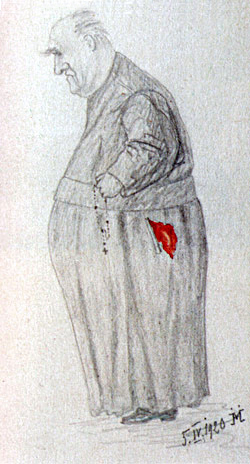English
 |
|
Caricatura o ingenuo ricordo? L’abate Joye con un fazzoletto rosso, in un disegno anonimo datato 5 aprile 1920. Archiv Borromäum, Basilea. Dal volume di Roland Cosandey Welcome Home, Joye! Film um 1910: Aus der Sammlung Joseph Joye, KINtop Schriften 1 (Basel: Stroemfeld Verlag, 1993), p. 17. Per gentile concessione dell’autore.
Caricature or naive memory? Abbé Joye with red handkerchief. Dated and signed 5 April 1920. Source: Archiv Borromäum, Basel. Courtesy of Roland Cosandey, from his book Welcome Home, Joye! Film um 1910: Aus der Sammlung Joseph Joye, KINtop Schriften 1 (Basel: Stroemfeld Verlag, 1993), p. 17. Courtesy of the author. |
|
| |
|
Lo svizzero Josef-Alexis Joye (1852-1919), abate dell'Ordine dei Gesuiti, è noto agli studiosi di cinema delle origini per l'importante repertorio di film da lui raccolto nei primi anni del Novecento. Nato a Romont, vicino a Friburgo, Joye aderì fin da giovane ai Gesuiti. Studiò in Germania e in Gran Bretagna, poi fece ritorno in Svizzera nel 1886 in qualità di parroco della Chiesa di Santa Clara a Basilea, dove mantenne l'incarico fino al 1911. Fu lì che Joye contribuì a creare nel 1898 un istituto educativo, più tardi chiamato Borromäum, a beneficio della comunità cattolica locale. Il suo intento era di aiutare le classi popolari del luogo mediante piani di assistenza agli orfani, scuole domenicali, programmi di educazione per gli operai e per gli immigrati.
È in tale contesto che Joye adottò il cinema come strumento pedagogico nelle sue attività al Borromäum. Nei due decenni a cavallo del secolo egli fece ampio uso delle proiezioni di lanterna magica, realizzando per proprio conto una quantità di lastre da utilizzare nelle proprie lezioni su argomenti quali la Bibbia, la storia del mondo, la scienza, le attualità. Nei primi anni del Novecento iniziò ad acquistare copie di film per impiegarle allo stesso scopo. Presi nel loro complesso, questi film formano oggi la Collezione Josef Joye.
Per ulteriori informazioni su Joye è utile consultare il volume di Roland Cosandey Welcome Home, Joye! Film um 1910: Aus der Sammlung Joseph Joye (Basel: Stroemfeld Verlag, 1993 [KINtop Schriften 1]) e il saggio di Joshua Yumibe "From Switzerland to Italy and All Around the World: The Josef Joye and Davide Turconi Collections", in Richard Abel, Giorgio Bertellini e Rob King (a cura di), Early Cinema and the "National" (Bloomington / New Barnet, UK: Indiana University Press / John Libbey, 2008), pp. 321-331.
Jesuit abbé Josef-Alexis Joye (1852-1919) collected in Switzerland in the early 1900s a large number of early films from that period. Joye was born in Romont, near Freiburg, and entered the Jesuit order as a young man. He studied in Germany and Great Britain and returned to Switzerland in 1886 as the Vicar of St. Clara Church in Basel, a position he held until 1911. There he worked to establish an instructional institution in 1898, later renamed the Borromäum, to strengthen the local Catholic community. Joye focused the institution on popular, community-based social programs: caring for and instructing orphans, providing Sunday school classes, and offering adult education programs for the working class and recent Catholic émigrés to the area.
It is within the context of the Borromäum that Joye turned to visual media for his pedagogical endeavors. In the 1890s and early 1900s he made extensive use of lantern slides, many of which he created himself for lectures on subjects ranging from biblical stories to historical topics, current events, and popular science. Also in the early 1900s, he began to collect films and incorporate them into his lectures. These films have become known as the Josef Joye Collection.
For further details on Joye, see Roland Cosandey, Welcome Home, Joye! Film um 1910: Aus der Sammlung Joseph Joye (Basel: Stroemfeld Verlag, 1993 [KINtop Schriften 1]); and Joshua Yumibe, "From Switzerland to Italy and All Around the World: The Josef Joye and Davide Turconi Collections," in Richard Abel, Giorgio Bertellini, and Rob King (eds.), Early Cinema and the "National" (Bloomington / New Barnet, UK: Indiana University Press / John Libbey, 2008), pp. 321-331.